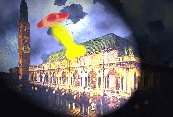|
DNA Analysis of Alleged Extraterrestrial Claw
Date: Tuesday, September 23 @ 01:16:29 EST
Topic: Alien related
In investigating cases of alleged anomalies, particularly when physical
evidence appears to corroborate the anomalous nature of an event, a
tendency to jump to hasty conclusions can manifest. Here we describe a
case in which multiple rounds of DNA analysis of a biological sample
appeared to corroborate its reported anomalous (extraterrestrial)
origins. In September 2000, an object resembling a claw was found by a
family in a bedroom of their Californian home. The family reported they
were in the midst of an intense series of visitations by purported
extraterrestrials. (read more to see large photo and download PDF)
Thus, the preliminary DNA analysis on this claw began to appear to “fit
in” with the multiple reports of high strangeness events as reported by
the primary eyewitnesses.
The linkage was made stronger because the anomalous biological sample
was found in the same bedroom in which numerous visitations and
intrusions by alleged extraterrestrials had occurred. Further, the
sample was found during a period of intense anomalous activity in the
same bedroom. Six separate rounds of subsequent DNA analysis, using
different and sometimes very novel approaches, were carried out to
bring this case to a conclusion.
It was necessary to invent a new polymerase chain reaction using novel
primers to the most conserved DNA sequences on Earth in order to
finally resolve this case.
Hence, painstaking DNA analyses and the use of bioinformatics
methodology over a 12 month period by highly qualified teams of experts
in three countries was necessary to establish that the biological
specimen found in the house was a mundane terrestrial mollusk.
Mollusks, particularly snails and slugs, secrete a thick mucous that
contains multiple inhibitors of many of the common enzymes that are
fundamental to molecular biology and DNA analysis, including polymerase
chain reaction enzymes and those used in standard molecular cloning.
Further, there is a relative paucity of mollusk DNA sequences,
particularly from mollusks found in California, in global DNA
databanks. These two factors conspired to lead this investigation down
a false path for about a year. Ultimately, however rigorous DNA
analysis using a novel set of oligonucleotide primers for the
polymerase chain reaction solved the puzzle.
The investigation of this case went far beyond the “business-as-usual”
analyses usually afforded anomaly cases. The project evolved into a
major molecular biology research project in its own right.
Independent confirmation that the sample was a dried mollusk was
obtained by an expert from the Los Angeles County Natural History
Museum.
The lessons from this intensive, lengthy and very expensive
investigation are simple and can be generalized for all anomaly
investigations:
(a) always follow the scientific data,
(b) resist the temptation to tie purported physical evidence with a nearby anomaly
until the analysis is fully completed,
(c) resist the impulse to publish (or publicize) during an ongoing investigation. It should be noted that the original anomalies reported by the family in their house
in California remain unexplained and are still being reported and
investigated.
Click the link below to download full DNA report, Adobe Acrobat Format
This article comes from Para-Normal.com
http://www.para-normal.com/nuke/html
The URL for this story is:
http://www.para-normal.com/nuke/html/modules.php?name=News&file=article&sid=1833
Collaborazione: Michele Bugliaro e Chucara2000
|
